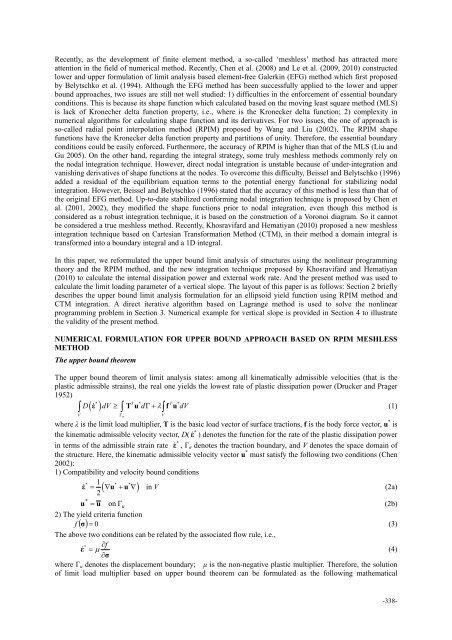r - The Hong Kong Polytechnic University
r - The Hong Kong Polytechnic University
r - The Hong Kong Polytechnic University
You also want an ePaper? Increase the reach of your titles
YUMPU automatically turns print PDFs into web optimized ePapers that Google loves.
Recently, as the development of finite element method, a so-called ‘meshless’ method has attracted more<br />
attention in the field of numerical method. Recently, Chen et al. (2008) and Le et al. (2009, 2010) constructed<br />
lower and upper formulation of limit analysis based element-free Galerkin (EFG) method which first proposed<br />
by Belytschko et al. (1994). Although the EFG method has been successfully applied to the lower and upper<br />
bound approaches, two issues are still not well studied: 1) difficulties in the enforcement of essential boundary<br />
conditions. This is because its shape function which calculated based on the moving least square method (MLS)<br />
is lack of Kronecher delta function property, i.e., where is the Kronecker delta function; 2) complexity in<br />
numerical algorithms for calculating shape function and its derivatives. For two issues, the one of approach is<br />
so-called radial point interpolation method (RPIM) proposed by Wang and Liu (2002). <strong>The</strong> RPIM shape<br />
functions have the Kronecker delta function property and partitions of unity. <strong>The</strong>refore, the essential boundary<br />
conditions could be easily enforced. Furthermore, the accuracy of RPIM is higher than that of the MLS (Liu and<br />
Gu 2005). On the other hand, regarding the integral strategy, some truly meshless methods commonly rely on<br />
the nodal integration technique. However, direct nodal integration is unstable because of under-integration and<br />
vanishing derivatives of shape functions at the nodes. To overcome this difficulty, Beissel and Belytschko (1996)<br />
added a residual of the equilibrium equation terms to the potential energy functional for stabilizing nodal<br />
integration. However, Beissel and Belytschko (1996) stated that the accuracy of this method is less than that of<br />
the original EFG method. Up-to-date stabilized conforming nodal integration technique is proposed by Chen et<br />
al. (2001, 2002), they modified the shape functions prior to nodal integration, even though this method is<br />
considered as a robust integration technique, it is based on the construction of a Voronoi diagram. So it cannot<br />
be considered a true meshless method. Recently, Khosravifard and Hematiyan (2010) proposed a new meshless<br />
integration technique based on Cartesian Transformation Method (CTM), in their method a domain integral is<br />
transformed into a boundary integral and a 1D integral.<br />
In this paper, we reformulated the upper bound limit analysis of structures using the nonlinear programming<br />
theory and the RPIM method, and the new integration technique proposed by Khosravifard and Hematiyan<br />
(2010) to calculate the internal dissipation power and external work rate. And the present method was used to<br />
calculate the limit loading parameter of a vertical slope. <strong>The</strong> layout of this paper is as follows: Section 2 briefly<br />
describes the upper bound limit analysis formulation for an ellipsoid yield function using RPIM method and<br />
CTM integration. A direct iterative algorithm based on Lagrange method is used to solve the nonlinear<br />
programming problem in Section 3. Numerical example for vertical slope is provided in Section 4 to illustrate<br />
the validity of the present method.<br />
NUMERICAL FORMULATION FOR UPPER BOUND APPROACH BASED ON RPIM MESHLESS<br />
METHOD<br />
<strong>The</strong> upper bound theorem<br />
<strong>The</strong> upper bound theorem of limit analysis states: among all kinematically admissible velocities (that is the<br />
plastic admissible strains), the real one yields the lowest rate of plastic dissipation power (Drucker and Prager<br />
1952)<br />
* T * T *<br />
D ε& dV ≥ TudΓ+<br />
λ f udV<br />
(1)<br />
∫ ( ) ∫ ∫<br />
V<br />
Γσ<br />
V<br />
where λ is the limit load multiplier, T is the basic load vector of surface tractions, f is the body force vector, u * is<br />
the kinematic admissible velocity vector, D( ε& * ) denotes the function for the rate of the plastic dissipation power<br />
*<br />
in terms of the admissible strain rate ε& , Γ σ denotes the traction boundary, and V denotes the space domain of<br />
the structure. Here, the kinematic admissible velocity vector u * must satisfy the following two conditions (Chen<br />
2002):<br />
1) Compatibility and velocity bound conditions<br />
1<br />
ε& * = ( ∇ u * + u<br />
* ∇)<br />
in V<br />
(2a)<br />
2<br />
*<br />
u = u on Γ u<br />
(2b)<br />
2) <strong>The</strong> yield criteria function<br />
f ( σ) = 0<br />
(3)<br />
<strong>The</strong> above two conditions can be related by the associated flow rule, i.e.,<br />
* f<br />
ε& = μ ∂<br />
(4)<br />
∂σ<br />
where Γ u denotes the displacement boundary; μ is the non-negative plastic multiplier. <strong>The</strong>refore, the solution<br />
of limit load multiplier based on upper bound theorem can be formulated as the following mathematical<br />
-338-

















